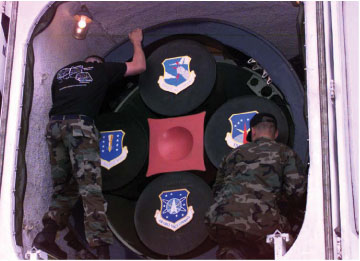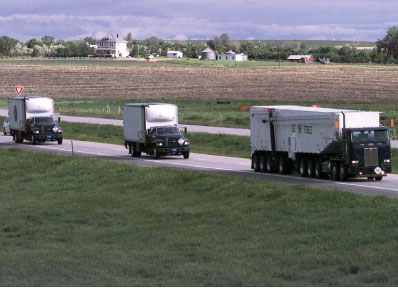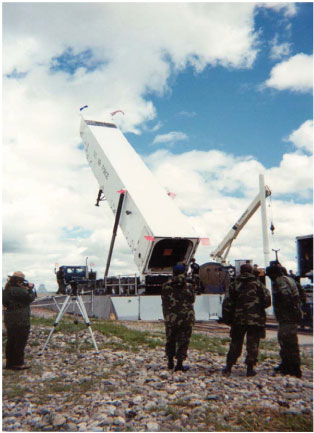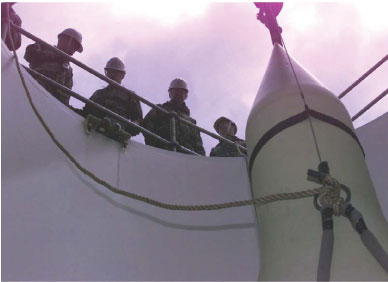Minuteman Historic Site Selection and Preparation
In creating Minuteman Missile National Historic Site, the American government has transformed what was once a secret and well-guarded location into a public space. As a component of the National Park System, the site will be preserved for future generations to learn first hand of the Minuteman missile's role in the Cold War. This was the hope of Soviet and American leaders even at the end of their bitter bipolar standoff. The terms of the Treaty Between the United States of America and the Union of the Soviet Socialist Republics on the Reduction and Limitation of Strategic Offensive Arms (START Treaty), allow both the United States and the Soviet Union to preserve examples of their Cold War armaments as static displays for public education purposes. The Minuteman II installations of the 44th Strategic Missile Wing (SMW) at Ellsworth Air Force Base drew the attention of the National Park Service (NPS) and the Air Force during the deactivation of Minuteman II ICBMs, since the Launch Facilities (LFs) and Launch Control Facilities (LCFs) in the 44th SMW displayed original technology developed for the early Minuteman I ICBM system. The LFs and LCFs of Ellsworth Air Force Base remain largely as originally constructed, and reflect the massive retaliation strategy that governed the first Minuteman I installations. For these reasons, the NPS focused on the South Dakota Minuteman LFs and LCFs when selecting an LF and an LCF for preservation.
In 1993 the NPS and the Air Force selected Delta-01 LCF and Delta-09 LF of the 44th SMW for preservation. Delta-01 and Delta-09 were chosen over other sites in South Dakota for the physical integrity of the LF and LCF and for their location near other historic sites, federal lands, and Interstate 90. Minuteman Missile National Historic Site is located within easy driving distance of Badlands National Park, Mount Rushmore National Memorial and the Black Hills National Forest. Buffalo Gap National Grassland is adjacent to the LCF and LF, providing a protected natural setting for the historic site.
The NPS's Rocky Mountain Regional Office and the Air Force entered into a series of Interagency Agreements to coordinate the effort to convert Delta-01 and Delta-09 into static displays. The first such agreement, signed in 1993, committed the NPS to completing a Special Resource Study to determine formally that Delta-01 and Delta-09 were the best choice for preservation of a Minuteman II LCF and LF. This study considered the suitability and feasibility of developing Delta-01 and Delta-09 into a National Historic Site and investigated alternatives for managing the site. The study also considered the environmental and socioeconomic conditions in the area and what effect the new historic site might have on these variables. Funding for the Special Resource Study came from the Department of Defense's "Legacy Resource Management Program," which awarded the NPS a $150,000 grant to study alternatives for preserving examples of America's Cold War history. The NPS completed the Special Resource Study in 1995.
The work to deactivate Delta-01 LCF and Delta-09 LF differed dramatically from the procedures followed for the other Minuteman II missile sites in South Dakota. The Air Force deactivated both sites but did not dismantle them. Instead, the NPS and the Air Force began planning for conversion of these two sites into monuments to the Cold War and the nuclear threat that existed during the second half of the twentieth century. The Air Force prepared special supplemental orders for these two sites. At the same time, deactivation of Delta-01 and Delta-09 needed to be completed in compliance with the START Treaty. Some of the deactivation tasks included those on the standard Air Force deactivation list, for example removing classified information and hazardous materials. The Air Force removed the Minuteman II missile at Delta-09, severed the Hardened Intersite Cable System (HICS), disconnected or removed other military communications equipment, and disconnected alarm systems used during the Cold War. The technical order for Delta-01 required severing and removal of a one-foot section of the HICS to prevent any future restoration of communications between Delta-01 and Delta-09, overwriting of the Weapon System Controller/Digital Store and Processor, removing all classified information from the site, installation of non-functioning radio control panels, and the replacement of any missing face plates to cover exposed drawer openings. Diesel storage tanks were also removed. Mechanical equipment such as the electrical system, air filtering systems, and heating system remained intact and interior furnishings, including tables, sofas and chairs were retained. The deactivation procedures checklist for Delta-01 was completed on 11 May 1993, however it is not known if this is the last day crews were on the site, or if they had left Delta-01 earlier. Delta-01 and Delta-09 continued in caretaker status until they were transferred to the NPS. During the period of caretaker status, both NPS and Air Force personnel performed basic maintenance at Delta-01 and Delta-09, upgraded fire and security systems, and installed a viewing enclosure over the missile launcher at Delta-09.
After deactivation, the NPS and the Air Force continued to work together to assure that the proposed Minuteman Missile National Historic Site became a reality. Interagency Agreements between the two organizations continued to coordinate the activities related to the historic site development. In 1995 Historic American Engineering Record documentation for the two sites were prepared with funding from the U.S. Department of Defense Legacy Resource Management Program.lxvii In 1996 the NPS and the Air Force developed a conversion plan to convert Delta-09 into a static display and the two agencies also finalized plans which included a viewing enclosure to allow future visitors the opportunity to see into the silo. Construction on the enclosure began in 2001. Other activities included the Air Force's sponsorship of a draft National Historic Landmark nomination that was not submitted to NPS for designation.
South Dakota Senators Tom Daschle and Tim Johnson introduced a bill to establish Minuteman Missile National Historic Site in 1998 and Congress began hearing testimony on the bill that same year. The bill failed in 1998 and was reintroduced the following year to the 106th Congress. Representatives from the NPS and the Air Force testified in favor of establishing the site. By 1999 both the House and Senate passed legislation creating Minuteman Missile National Historic Site and the federal budget for that year included $5 million to help preserve Delta-01 and Delta-09. The law describes the purpose of Minuteman Missile National Historic Site as:
To preserve, protect, and interpret for the benefit and enjoyment of present and future generations the structures associated with the Minuteman II missile defense system;
1. to interpret the historical role of the Minuteman II missile defense system–
a. as a key component of America's strategic commitment to preserve world peace; and
b. in the broader context of the Cold War; and
2. to complement the interpretive programs relating to the Minuteman II missile defense system offered by the South Dakota Air and Space Museum at Ellsworth Air Force Base.
After the federal government officially endorsed the creation of the historic site, the NPS and the Air Force began preparations for the opening of the LF and LCF to the public. Once the legislation was passed, the specific plans to convert Delta-09 to a static display were formally presented to the START Compliance Review Group in Washington, D.C. for approval. Moreover, the new law gave the NPS funds to produce a general management plan for the site. A general management plan attempts to establish a clear management philosophy and provide direction for interpretive themes, resource preservation, and visitor use.
The NPS began work on the general management plan for the site in the spring of 2001 and hosted a series of public meetings to gather input from interested groups and individuals on their vision for the new historic site. The general management planning team included representatives from the Air Force, Forest Service, South Dakota Air & Space Museum, Badlands National Park, NPS Midwest Regional office, NPS Denver Service Center, and NPS Harper's Ferry Center.lxxi The general management plan is expected to be available for public comment in the summer of 2004 and finalized in late 2004 or early 2005.
While the NPS occupied itself with the general management plan for Minuteman Missile National Historic Site, the Air Force worked on the conversion of the Delta-09 LF to a static display to comply with the START Treaty. This conversion was necessary prior to the transfer of ownership to the NPS. The Air Force worked to acquire an unarmed training missile and refurbished and painted the missile prior to shipping it to Delta-09. Procuring the display missile proved no small task for the Air Force staff working on the site with the NPS. Intense competition for training missiles and/or static display missiles existed, as military museums also desired their own Minuteman II ICBMs for their exhibits. Additionally, many of the high level officers who once staffed the Air Force's six operational missile wings had moved on after their wings were deactivated. These colonels and generals had supported the establishment of a monument to the Cold War and their transfer or retirement reduced high-level support for the new historic site and made obtaining a deactivated Minuteman II ICBM more difficult.
Once Air Force staff at Ellsworth had located the component parts of a training missile at Hill Air Force Base in Utah, technicians at Hill Air Force Base refurbished the object.lxxiii On 12 June 2001 the Air Force emplaced the missile in the Delta-09 silo using a Transporter Erector vehicle designed to emplace Minuteman Missiles. Missile crews from 90th Logistics Group at F.E. Warren Air Force Base in Wyoming, many of whom were based at Ellsworth during the Cold War, assisted in the installation of the training missile. Local media were invited to the emplacement, increasing the profile of Minuteman Missile National Historic Site.
Construction of a viewing enclosure for the missile silo began shortly thereafter. The design of the enclosure represented a joint effort between the NPS and the Air Force and met START Treaty requirements and interpretive needs. The enclosure allows viewing below grade with minimal visual impact to the site. To complete the viewing enclosure and platform, the Air Force opened the silo door one- foot past halfway and welded and grouted the door in place. Crews then placed a glass enclosure and stainless steel railing around the silo opening. Future visitors will be able to approach the silo and peer down at the Minuteman II display missile in the silo. By 15 August 2001 the viewing enclosure was largely completed. After the installation of the static display missile and the completion of the viewing enclosure, a Soviet inspection team traveled to South Dakota on 21 May 2002 to verify that Delta-09 complied with the START Treaty's specifications for static displays.
The Air Force and the NPS conducted a formal transfer of ownership of Delta-01 and Delta-09 to the NPS after the work of converting Delta-01 and Delta-09 was complete. On 27 September 2002, exactly eleven years to the day from stand down, the Air Force officially turned Minuteman Missile National Historic Site over to the NPS at a ceremony at Delta-09. The festivities included a B-1 flyover, presentation of colors by the Ellsworth Air Force Base Honor Guard, a performance by the Rapid City Central High School Marching Band, speeches by Fran Mainella, Director of the NPS, and Lieutenant General Robert Hinson, Vice Commander Air Force Space Command. Craig Manson, Assistant Secretary for Fish and Wildlife and Parks, Department of the Interior and former missileer, spoke of his memories as an officer of the 44th SMW at Ellsworth. Colonel James Kowalski, Commander of the 28th Bomb Wing, then transferred the keys to Delta-01 and Delta-09 to William Supernaugh, Superintendent, Badlands National Park.
As of 2003, minor modifications had occurred to Delta-01 and Delta-09 in preparation for their opening as Minuteman Missile National Historic Site. New security and fire detection/suppression systems were installed at Delta-01 and Delta-09. Delta-01 remained largely as it was when it was deactivated and care has been taken to keep as much of the original mechanical equipment and historic furnishings at the site. The NPS plans to open Minuteman Missile National Historic Site to the general public, following the completion of an interpretive visitor center, anticipated in 2006.
If not for the dedication of many individuals, both at the Air Force and the NPS, Minuteman Missile National Historic Site site would not have become a reality. For the Air Force and former missileers, the establishment of the historic site provides the opportunity for the public to view their contribution to winning the Cold War. Former missileer Craig Manson stated that the preservation of Delta-01 and Delta-09 "is a most fitting idea because, for this reason, the Cold War dominated the last half of the twentieth century, and some will not believe this or accept this, but most of American life, in one way or another, was defined by the Cold War."

The training missile in the transporter erector prior to emplacement in the Delta-09 silo

Convoy transporting training missile for emplacement at Delta-09

Transporter Erector ready to emplace the training missile at Delta-09

Training missile emplacing, Delta-09 silo